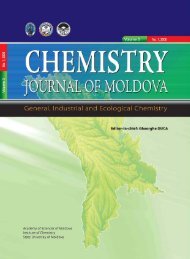stiinte med 1 2012.indd - Academia de ÅtiinÅ£e a Moldovei
stiinte med 1 2012.indd - Academia de ÅtiinÅ£e a Moldovei
stiinte med 1 2012.indd - Academia de ÅtiinÅ£e a Moldovei
You also want an ePaper? Increase the reach of your titles
YUMPU automatically turns print PDFs into web optimized ePapers that Google loves.
Ştiinţe Medicale<br />
35. Busjahn A. , et al., QT interval is linked to 2 long-<br />
QT syndrome loci in normal subjects. Circulation, 1999;<br />
99: 3161–3164.<br />
36. Sotoo<strong>de</strong>hnia N., Isaacs A., et al., Common variants<br />
in 22 loci are associated with QRS duration and cardiac<br />
ventricular conduction. Net. Genet., 2010; 42: 1068-1076.<br />
37. Braz J.C., et al., PKC-alpha regulates cardiac<br />
contractility and propensity toward heart failure. Nat.<br />
Med., 2004; 10:248–254.<br />
38. Wei L., Hanna A.D., Beard N.A., Dulhunty A.F.,<br />
Unique isoform-specifi c properties of calsequestrin in the<br />
heart and skeletal muscle. Cell Calcium, 2009; 45: 474–<br />
484.<br />
39. Priori S.G., et al., Clinical and molecular<br />
characterization of patients with catecholaminergic<br />
polymorphic ventricular tachycardia. Circulation, 2002;<br />
106: 69–74.<br />
40. Meurs K.M., et al., Genome-wi<strong>de</strong> association<br />
i<strong>de</strong>ntifi es a <strong>de</strong>letion in the 3′ untranslated region of Striatin<br />
in a canine mo<strong>de</strong>l of arrhythmogenic right ventricular<br />
cardiomyopathy. Hum. Genet., 2010; 128:315–324.<br />
41. Singh R., et al., Tbx20 interacts with smads to<br />
confi ne tbx2 expression to the atrioventricular canal. Circ.<br />
Res., 2009; 105: 442–452.<br />
42. Posch M.G., et al., A gain-of-function TBX20<br />
mutation causes congenital atrial septal <strong>de</strong>fects, patent<br />
foramen ovale and cardiac valve <strong>de</strong>fects. J. Med. Genet.,<br />
2009; 47: 230–235.<br />
43. Reamon-Buettner S.M., et al., A functional genetic<br />
study i<strong>de</strong>ntifi es HAND1 mutations in septation <strong>de</strong>fects of<br />
the human heart. Hum. Mol. Genet., 2009; 18:3567–3578.<br />
44. Breckenridge R.A., et al., Overexpression of the<br />
transcription factor Hand1 causes predisposition towards<br />
arrhythmia in mice. J. Mol. Cell. Cardiol., 2009; 47: 133–<br />
141.<br />
45. Besson A.,Yong, V.W., Involvement of p21(Waf1/<br />
Cip1) in protein kinase C alpha-induced cell cycle<br />
progression. Mol. Cell. Biol., 2000; 20:4580–4590.<br />
46. Svati H.S., Geoffrey S.P., Genetics of cardiac<br />
repolarization. Net. Genet., 2009; 41: 388-389.<br />
47. Splawski I., et al., Spectrum of mutations in long-<br />
QT syndrome genes. KVLQT1, HERG, SCN5A, KCNE1,<br />
and KCNE2. Circulation, 2000; 102:1178–1185.<br />
48. Arking D.E., et al., A common genetic variant<br />
in the NOS1 regulator NOS1AP modulates cardiac<br />
repolarization. Nat. Genet., 2006; 38:644–651.<br />
49. Aarnoudse A.J., et al., Common NOS1AP variants<br />
are associated with a prolonged QTc interval in the<br />
Rotterdam Study. Circulation, 2007; 116:10–11.<br />
50. Post W., et al., Associations between genetic<br />
variants in the NOS1AP (CAPON) gene and cardiac<br />
repolarization in the old or<strong>de</strong>r Amish. Hum. Hered., 2007;<br />
64:214–219.<br />
51. Tobin M.D., et al., Gen<strong>de</strong>r and effects of a common<br />
genetic variant in the NOS1 regulator NOS1AP on cardiac<br />
repolarization in 3761 individuals from two in<strong>de</strong>pen<strong>de</strong>nt<br />
populations. Int. J. Epi<strong>de</strong>miol., 2008; 37:1132–1141.<br />
79<br />
52. Pfeufer A., Sanna S., Arking D.E., et al., Common<br />
variants in ten loci modulate QT interval duration in the<br />
QTSCD study. Nat. Genet., 2009; 41:407-414.<br />
53. Newton-Cheh C., Eijgelsheim M., Rice K., et<br />
al., Common variants at ten loci infl uence QT interval<br />
duration in the QTGEN Study. Nat. Genet., 2009; 41:399-<br />
406.<br />
54. Ревишвили А.Ш. с соав., Опыт применеия методов<br />
ДНК-диагностики в лечении больных с синдромом<br />
удлиненного интервала QT. ВА, 2006; 42:28-34.<br />
Rezumat<br />
Parametrii electrocardiografiсi (ECG) servesc<br />
drept indicatori ai funcţionării sistemului <strong>de</strong> conducere<br />
cardiac. Dereglările acestui sistem duc la fibrilaţie atrială,<br />
bradiaritmii care pun viaţa în pericol, <strong>de</strong> exemplu blocajul<br />
cardiac, tahiaritmii – fibrilaţie ventriculară şi moarte subită<br />
cardiacă. Înţelegerea contribuţiei genetice la conducerea<br />
cardiacă este importantă pentru clarificarea căilor biologice<br />
care duc la aceste <strong>de</strong>vieri. Pentru a i<strong>de</strong>ntifica variantele<br />
genetice ale caracterelor cantitative, cum sunt intervalele<br />
ECG, pot fi utilizate studiile <strong>de</strong> asociere largă a genomului<br />
(GWAS). Acest articol <strong>de</strong>scrie genele şi variantele lor, care<br />
afectează conducerea cardiacă, i<strong>de</strong>ntificate prin inter<strong>med</strong>iul<br />
GWAS.<br />
Summary<br />
Electrocardiographic measures (ECG parameters)<br />
are indicative of the function of the cardiac conduction<br />
system. The dysfunctions of this system lead to atrial<br />
fibrillation, life-threatening bradyarrhythmias, such<br />
as heart block, tachyarrhythmias, such as ventricular<br />
fibrillation and sud<strong>de</strong>n cardiac <strong>de</strong>ath. Un<strong>de</strong>rstanding<br />
the genetic contribution to cardiac conduction is important to<br />
clarify the biological pathways to lead to data breaches. To<br />
i<strong>de</strong>ntify the genetic variants of quantitative traits, such<br />
as ECG intervals, can be used genome-wi<strong>de</strong> association<br />
study (GWAS). This article <strong>de</strong>scribes genes and their<br />
variants i<strong>de</strong>ntified by the GWAS, affecting cardiac<br />
conduction.<br />
Резюме<br />
Электрокардиографические меры (параметры<br />
ЭКГ) свидетельствуют о функции проводящей системы<br />
сердца. Нарушения в данной системе приводят к<br />
фибрилляциям предсердий, к жизнеугрожающим брадиаритмиям,<br />
таким как блокада сердца, тахиаритмиям<br />
– фибрилляция желудочков и к внезапной сердечной<br />
смерти. Понимание генетического вклада в сердечную<br />
проводимость важно для выяснения биологических<br />
путей, приводящих к данным нарушениям. Для идентификации<br />
генетических вариантов количественных<br />
признаков, таких как интервалы ЭКГ, могут быть использованы<br />
полногеномные исследования ассоциаций<br />
(GWAS). В данной статье описаны гены и их варианты,<br />
выявленные с помощью GWAS, влияющие на сердечную<br />
проводимость.

















